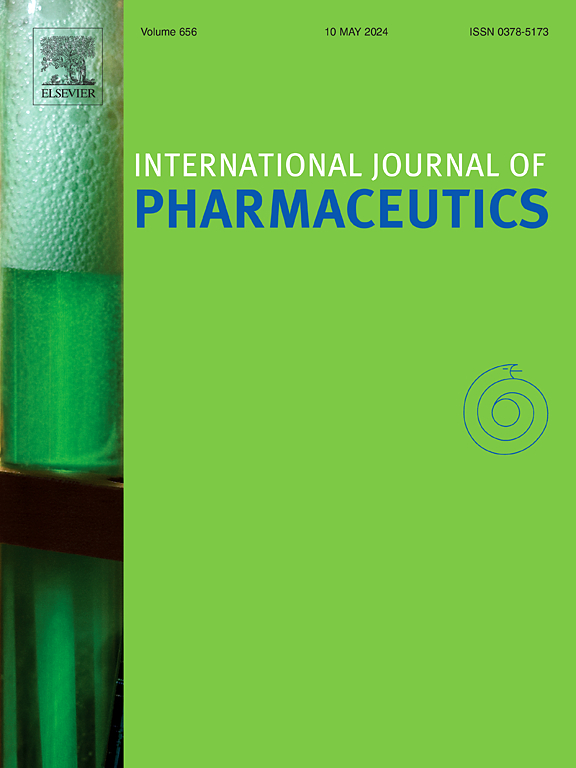载溴隐肽甲磺酸纳米颗粒与低分子量鱼精蛋白和乳铁蛋白共修饰,用于增强帕金森病治疗中的鼻至脑递送。
IF 5.3
2区 医学
Q1 PHARMACOLOGY & PHARMACY
引用次数: 0
摘要
由于血脑屏障的存在,帕金森病在给药方面面临挑战。经鼻给药可绕过血脑屏障提高药物的生物利用度,但狭窄的鼻腔空间和短暂的保留时间阻碍了临床应用。研究人员利用低分子量鱼精蛋白(LMWP)和乳铁蛋白(Lf) (LMWP/Lf- bcm - nps)共修饰了溴隐肽甲磺酸负载的PLGA纳米颗粒,用于鼻至脑递送。所得LMWP/Lf-BCM-NPs为均匀球形,平均粒径为248.53 ± 16.25 nm, Zeta电位为-2.63 ± 0.74 mV。傅里叶变换红外光谱证实了LMWP和Lf的附着。共修饰的纳米颗粒具有改善细胞运输和良好的生存能力。LMWP/Lf-BCM-NPs在小鼠中显示出更高的脑靶向效率。在氟哌啶醇诱导的帕金森小鼠模型中,LMWP/Lf-BCM-NPs表现出更高的脑靶向效率,增强的行为调节作用,增强的抗氧化作用和神经保护作用。这项研究为一种新的、非侵入性的脑靶向治疗铺平了道路,为帕金森病的临床治疗提供了一条有希望的途径。本文章由计算机程序翻译,如有差异,请以英文原文为准。

Bromocriptine mesylate-loaded nanoparticles co-modified with low molecular weight protamine and lactoferrin for enhanced nose-to-brain delivery in Parkinson’s disease treatment
Parkinson’s disease confronts challenges in drug delivery due to the blood-brain barrier. Intranasal delivery bypasses the blood-brain barrier for improved drug bioavailability, yet narrow nasal space and brief retention time hinder clinical applicability. We conducted a Bromocriptine Mesylate-loaded PLGA nanoparticles co-modified with low molecular weight protamine (LMWP) and lactoferrin (Lf) (LMWP/Lf-BCM-NPs) for nose-to-brain delivery. The resulting LMWP/Lf-BCM-NPs were uniform spheres with an average size of 248.53 ± 16.25 nm and zeta potential of −2.63 ± 0.74 mV. Fourier transform infrared spectroscopy confirmed LMWP and Lf attachment. The co-modified nanoparticles showed improving cellular transport and good viability. The LMWP/Lf-BCM-NPs showed increased brain targeting efficiency in mice. In haloperidol-induced Parkinson mouse models, the LMWP/Lf-BCM-NPs showed increased brain targeting efficiency, enhanced behavioral regulatory effects, enhanced antioxidant effects and neuroprotection effects. This study paves the way for a novel, non-invasive brain-targeted therapy, offering a promising avenue for Parkinson’s disease clinical treatment.
求助全文
通过发布文献求助,成功后即可免费获取论文全文。
去求助
来源期刊
CiteScore
10.70
自引率
8.60%
发文量
951
审稿时长
72 days
期刊介绍:
The International Journal of Pharmaceutics is the third most cited journal in the "Pharmacy & Pharmacology" category out of 366 journals, being the true home for pharmaceutical scientists concerned with the physical, chemical and biological properties of devices and delivery systems for drugs, vaccines and biologicals, including their design, manufacture and evaluation. This includes evaluation of the properties of drugs, excipients such as surfactants and polymers and novel materials. The journal has special sections on pharmaceutical nanotechnology and personalized medicines, and publishes research papers, reviews, commentaries and letters to the editor as well as special issues.

 求助内容:
求助内容: 应助结果提醒方式:
应助结果提醒方式:


